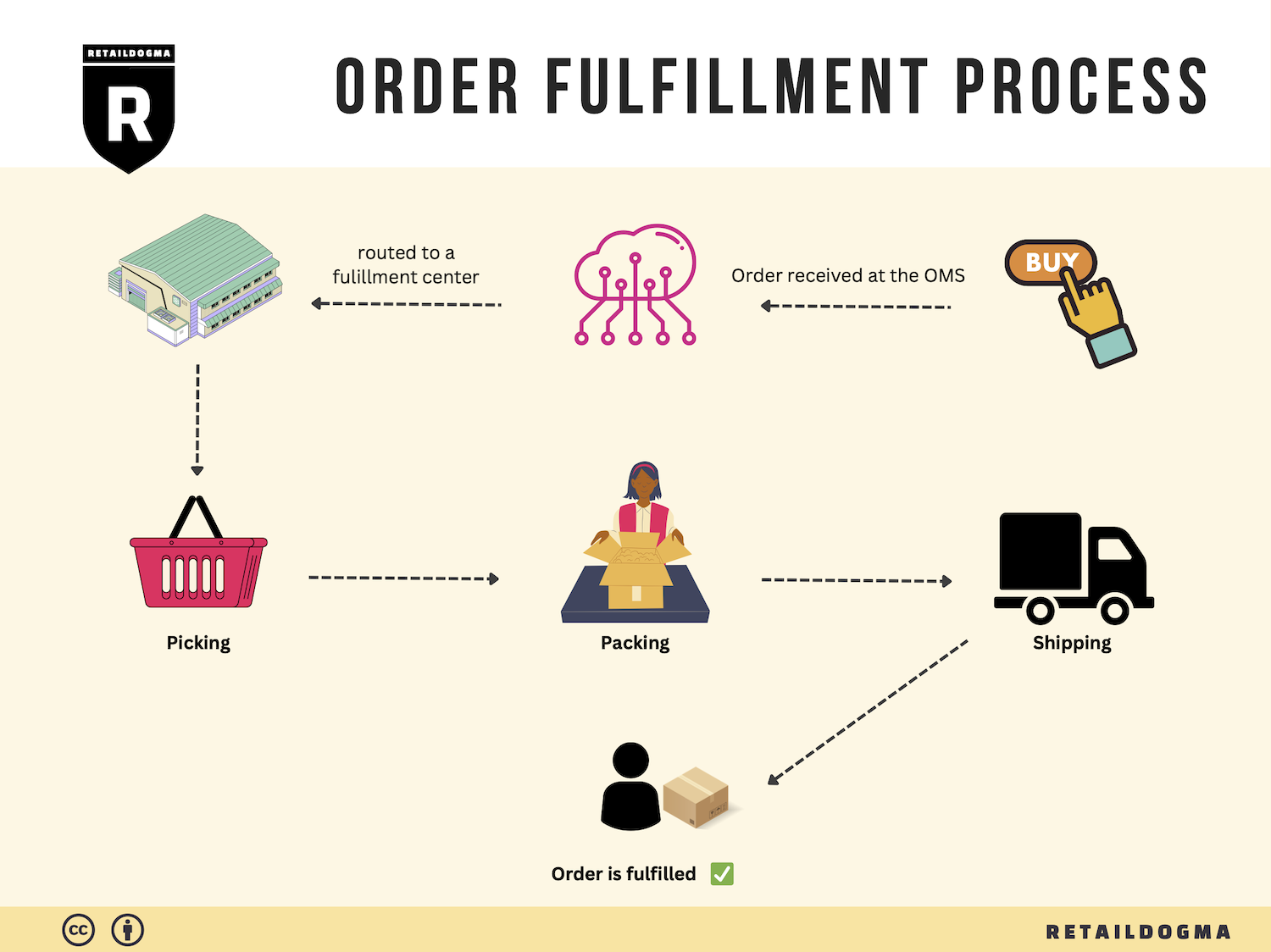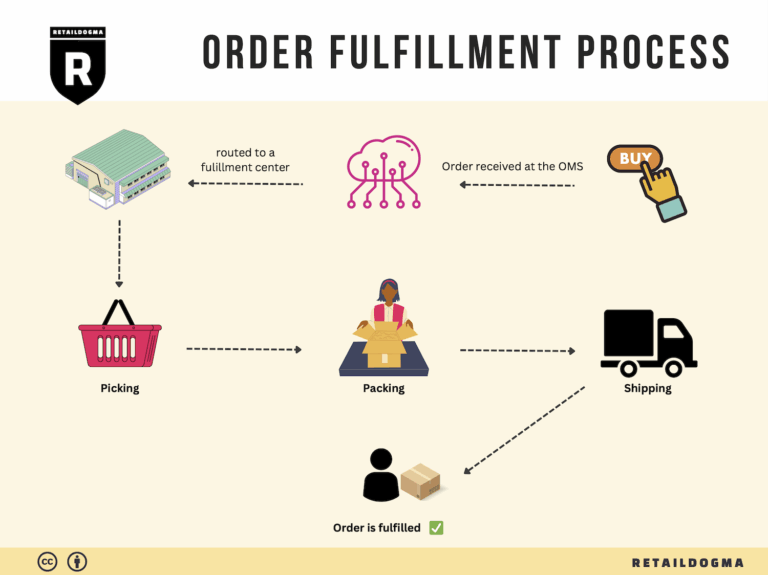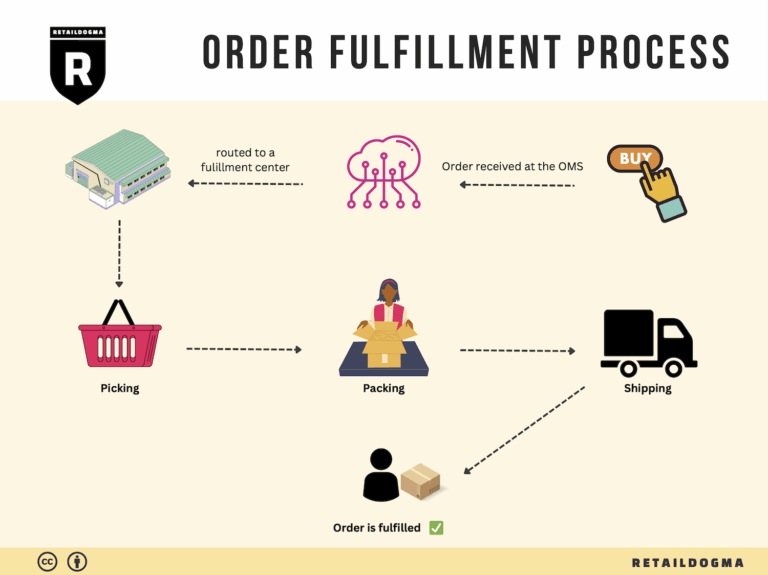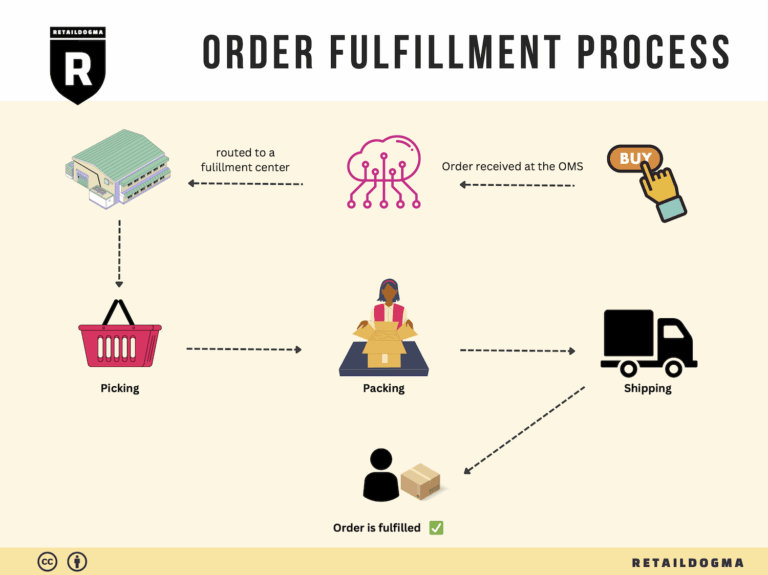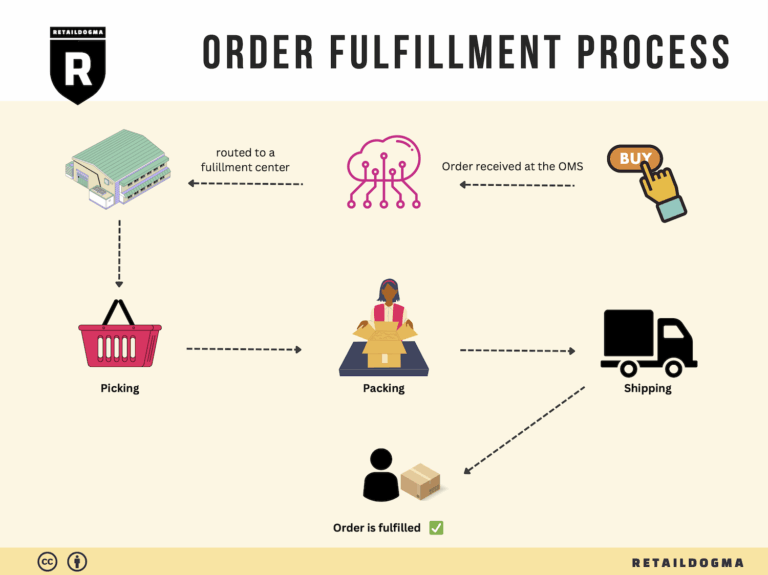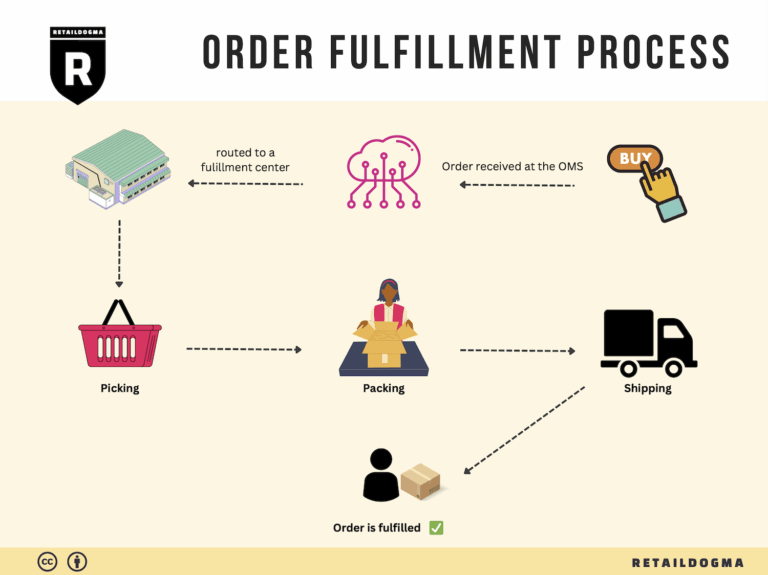How Order Fulfillment Works: A Step-by-Step Guide for Businesses
What is E-commerce Fulfillment? An Introduction for Growing Businesses
Understanding the Fulfillment Process
As your online business begins to thrive, you might find yourself facing a daunting challenge: managing the logistics of packing and shipping orders. This is a common pain point for many growing e-commerce businesses. While you’re focused on scaling your sales and expanding your product offerings, the logistics of getting products into customers’ hands can become overwhelming. This is where e-commerce fulfillment comes into play.
At its core, fulfillment is the process of getting a product from your inventory to your customer. It encompasses a range of activities, including receiving inventory, warehousing products, picking and packing orders, shipping them to customers, and managing returns. The efficiency of this process can significantly impact your customer satisfaction, as well as your operational costs.
In this guide, we will delve into the various models of e-commerce fulfillment available to businesses today. You may have heard of Fulfillment by Amazon (FBA), which allows sellers to leverage Amazon’s vast logistics network, or Third-Party Logistics (3PL) providers that offer comprehensive warehousing and distribution services tailored to your specific needs. Understanding these options will help you choose the best fit for your business.
We will also explore the core services involved in fulfillment, including inventory management, order processing, and customer service. Each of these components plays a crucial role in creating a seamless experience for your customers and ensuring that your operations run smoothly.
Choosing the right fulfillment partner is critical for your business’s success. This guide will outline key factors to consider when evaluating potential partners, including their experience, technology capabilities, and pricing structures. We will break down typical costs associated with various fulfillment models so that you can make informed financial decisions.
Ultimately, the goal of this guide is to empower you—business owners, operations managers, and entrepreneurs—to make smart decisions about your logistics. By understanding the fulfillment landscape and the options available, you can streamline your operations, reduce costs, and enhance customer satisfaction. Let’s embark on this journey to simplify your fulfillment process and drive your business growth.
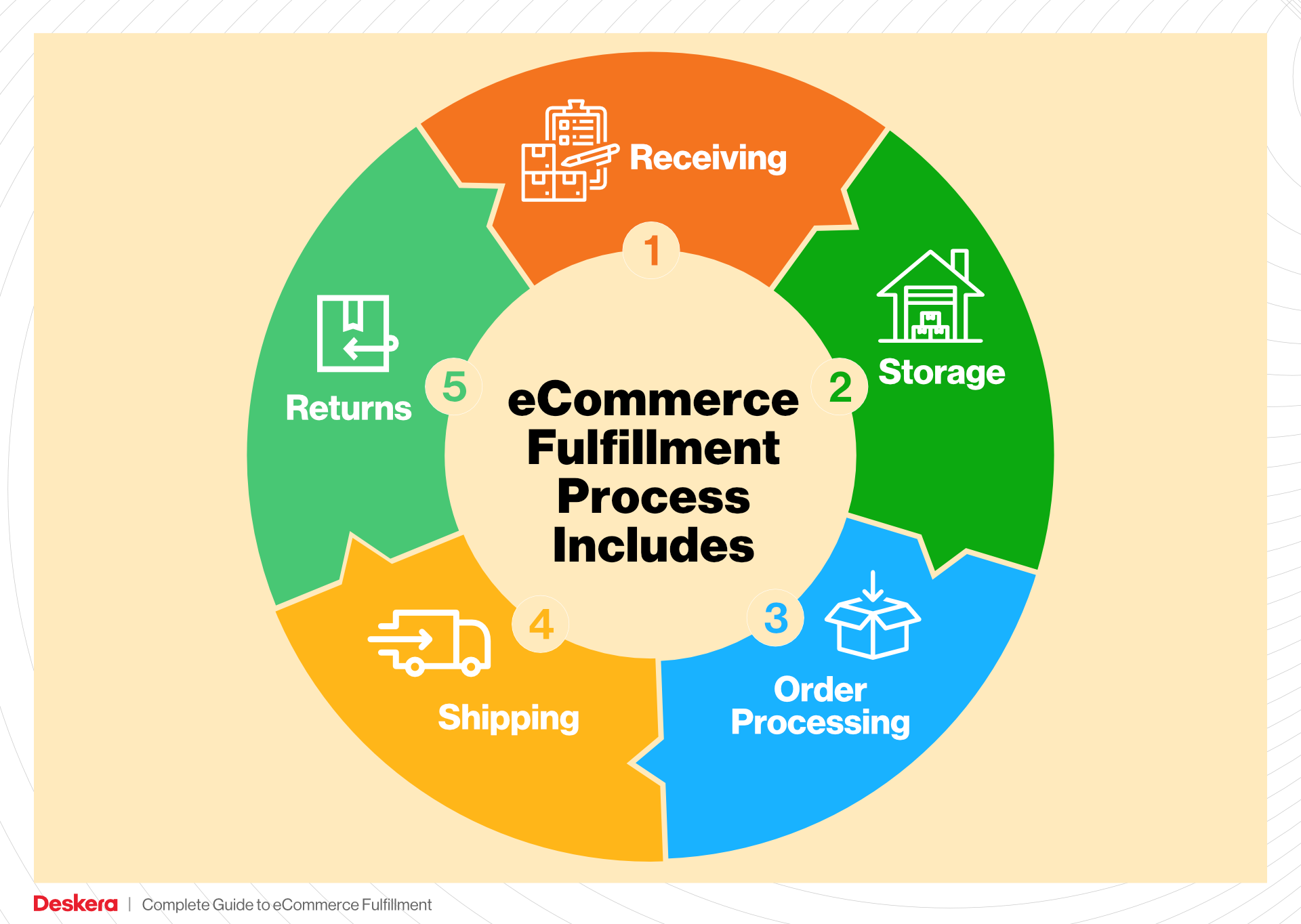
What You’ll Learn In This Guide
- What is E-commerce Fulfillment? An Introduction for Growing Businesses
- The Order Fulfillment Process: From ‘Buy’ Button to Customer’s Door
- Comparing Fulfillment Models: In-House vs. 3PL vs. Dropshipping
- A Deep Dive into Amazon FBA: Pros, Cons, and Who It’s For
- Core Services Offered by Fulfillment Centers
- How to Choose a Fulfillment Partner: A 6-Point Checklist
- Understanding Fulfillment Pricing: A Breakdown of Common Fees
- Frequently Asked Questions (FAQs) about Fulfillment
- Conclusion: Is Outsourcing Fulfillment the Right Move for Your Business?
- Important Disclaimer
The Order Fulfillment Process: From ‘Buy’ Button to Customer’s Door
1. Receiving Inventory
The order fulfillment process begins with receiving inventory at a fulfillment center. This step is crucial as it ensures that the products intended for sale are correctly accounted for and ready for storage. Upon arrival, each product is inspected for quality and accuracy against purchase orders. This is where the concept of Stock Keeping Units (SKUs) comes into play. Each item is assigned a unique SKU that helps in tracking and managing inventory efficiently.
Proper receiving processes reduce errors and discrepancies in inventory levels, which can lead to stockouts or overstocking. When inventory is accurately received and logged into the system, businesses can maintain a seamless flow of goods, ultimately contributing to customer satisfaction through timely deliveries.
2. Warehouse Storage
Once the inventory is received, it moves to the storage area of the fulfillment center. This phase involves organizing the products in a manner that maximizes efficiency and accessibility. Different storage methods may be employed, such as pallet racking, shelving, or bin storage, depending on the nature and size of the products.
Effective warehouse storage is vital because it directly influences the speed of order fulfillment. A well-organized warehouse allows for quicker retrieval of items during the picking phase, reducing the time it takes to process orders. Key terms associated with this step include “ABC analysis,” which categorizes inventory based on its importance and turnover rate, helping businesses prioritize storage space for high-demand items.
3. Order Picking
Order picking is the process of retrieving items from storage to fulfill customer orders. This step is essential, as it directly impacts the accuracy and efficiency of the fulfillment process. Warehouse staff use pick lists—documents that outline the items and quantities needed for each order—to guide them through the retrieval process.
There are various picking methods, such as single order picking, batch picking, or zone picking, each suited for different business models and order volumes. The choice of method can significantly affect picking speed and accuracy. By optimizing the picking process, businesses can reduce labor costs and enhance the overall customer experience by ensuring orders are filled correctly and promptly.
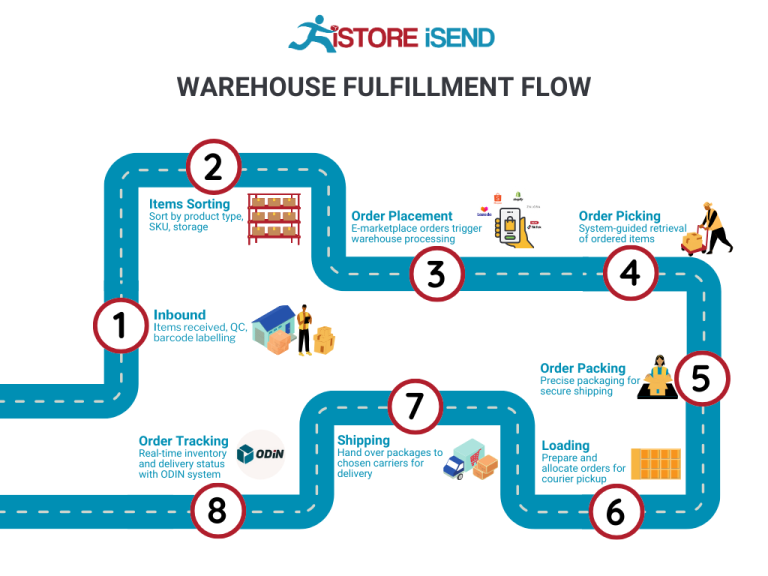
4. Order Packing
After items are picked, they move to the packing station, where they are prepared for shipment. Packing involves carefully placing products into boxes, along with any necessary documentation, such as invoices and return instructions. This step is critical because proper packing prevents damage during transit and ensures that the right items are sent to the customer.
Key considerations during packing include using appropriate packing materials, optimizing box sizes to reduce shipping costs, and including packing slips that confirm the order details. Efficient packing processes can lead to reduced shipping costs and increased customer satisfaction, as customers receive their orders in excellent condition and as expected.
5. Shipping & Delivery
The final step in the order fulfillment process is shipping and delivery. Once orders are packed, they are labeled and handed over to shipping carriers for delivery to customers. This phase is crucial as it determines how quickly customers receive their orders, which can significantly impact their satisfaction and likelihood of repeat purchases.
Shipping options may vary, including standard, expedited, or same-day delivery, depending on the business model and customer preferences. Key terms in this phase include “last-mile delivery,” which refers to the final step of the shipping process where the package is delivered to the customer’s doorstep. By optimizing shipping routes and methods, businesses can reduce costs and improve delivery times, ultimately enhancing the overall customer experience.
In summary, the order fulfillment process encompasses several critical steps, each contributing to the efficient delivery of products from the moment a customer clicks the ‘buy’ button until the package arrives at their door. By understanding and optimizing each phase—from receiving inventory to shipping and delivery—e-commerce businesses can scale effectively and maintain a competitive edge in the marketplace.
Comparing Fulfillment Models: In-House vs. 3PL vs. Dropshipping
Fulfillment Model Comparison Table
| Model | Who Handles Inventory | Best For (Business Stage) | Key Advantage | Key Disadvantage |
|---|---|---|---|---|
| In-House Fulfillment | The business itself | Startups to mid-sized businesses | Full control over inventory and shipping processes | High overhead costs and resource intensive |
| Third-Party Logistics (3PL) | 3PL provider | Growth stage businesses | Cost savings and scalability | Less control over operations and potential service variability |
| Dropshipping | Supplier or manufacturer | New businesses or niche markets | Low startup costs and no inventory management | Lower profit margins and dependency on suppliers |
In-House Fulfillment
In-house fulfillment refers to the process where a business manages its own warehousing, inventory, and order processing. This model is typically employed by startups and mid-sized businesses that desire complete control over their logistics. The primary advantage of in-house fulfillment is the ability to maintain oversight of every aspect of inventory management and order fulfillment. Businesses can ensure quality control and tailor processes to meet specific needs. However, this model also comes with significant drawbacks, including high overhead costs associated with warehousing, labor, and technology. Moreover, as the business scales, the demands on resources can lead to inefficiencies and increased operational complexity. For businesses aiming for rapid growth, in-house fulfillment may become untenable, necessitating a transition to other models.
Third-Party Logistics (3PL)
Third-party logistics (3PL) providers offer a comprehensive solution for businesses looking to outsource their fulfillment processes. This model is particularly beneficial for companies in the growth stage, where scalability and cost management are crucial. By leveraging a 3PL, businesses can significantly reduce overhead costs associated with warehousing and shipping. These providers have established networks and expertise in logistics, allowing for faster shipping times and compliance with various marketplace requirements, such as Amazon’s strict fulfillment standards. However, while 3PLs can enhance operational efficiency, they also present challenges. Businesses may experience a loss of control over their inventory and fulfillment processes, which can lead to inconsistencies in service quality. Additionally, relying on a third party means that any issues in their operations could directly impact the business’s reputation and customer satisfaction.
Dropshipping
Dropshipping is an increasingly popular fulfillment model, particularly among new businesses and those targeting niche markets. In this model, the retailer does not hold any inventory; instead, they partner with suppliers who ship products directly to customers. The primary advantage of dropshipping is the low barrier to entry, as businesses do not need to invest in inventory upfront or manage warehousing. This can significantly reduce financial risk and operational complexity, making it an attractive option for entrepreneurs testing new products or markets. However, dropshipping also comes with notable disadvantages. Profit margins tend to be lower compared to other models, as retailers often pay higher prices to suppliers for the convenience of not holding inventory. Additionally, reliance on suppliers means that businesses have less control over product quality, shipping times, and stock levels, which can lead to customer dissatisfaction if not managed carefully.
Conclusion
Choosing the right fulfillment model is critical for e-commerce businesses as they scale. Each option—In-House, 3PL, and Dropshipping—has its unique advantages and challenges. In-house fulfillment offers control but at a higher operational cost, while 3PLs provide scalability and expertise at the expense of some control over the logistics process. Dropshipping offers a low-cost entry point with minimal overhead but may compromise profit margins and supplier reliability. Business owners must carefully assess their operational goals, resources, and market demands to select the fulfillment model that best aligns with their growth strategy and customer expectations.
A Deep Dive into Amazon FBA: Pros, Cons, and Who It’s For
Understanding Fulfillment by Amazon (FBA)
Fulfillment by Amazon (FBA) is a service offered by Amazon that allows sellers to store their products in Amazon’s fulfillment centers. Amazon then takes care of storage, packaging, and shipping of the products directly to customers. This service also includes handling customer service and returns, allowing sellers to focus on other aspects of their business, such as product development and marketing.
When a customer orders a product, Amazon picks, packs, and ships the item on behalf of the seller. This means that sellers can leverage Amazon’s vast logistics network, which can lead to faster delivery times and enhanced customer satisfaction. Furthermore, products fulfilled through FBA are eligible for Amazon Prime, which significantly increases their visibility and attractiveness to potential buyers.
How FBA Works
-
Product Preparation: Sellers prepare their products according to Amazon’s guidelines, which include labeling, packaging, and shipping requirements.
-
Shipping to Amazon: Once products are prepared, sellers ship them to Amazon’s designated fulfillment centers. Sellers can choose to send their inventory to multiple centers to optimize shipping times and costs.
-
Inventory Management: Amazon manages the inventory stored in its warehouses. Sellers can monitor their stock levels and sales data through the Amazon Seller Central dashboard.
-
Order Fulfillment: When a customer places an order, Amazon picks the product from the warehouse, packs it, and ships it directly to the customer. This process is typically very efficient, allowing for quick delivery.
-
Customer Service and Returns: Amazon handles all customer inquiries and returns for FBA products, providing a seamless experience for both sellers and buyers.
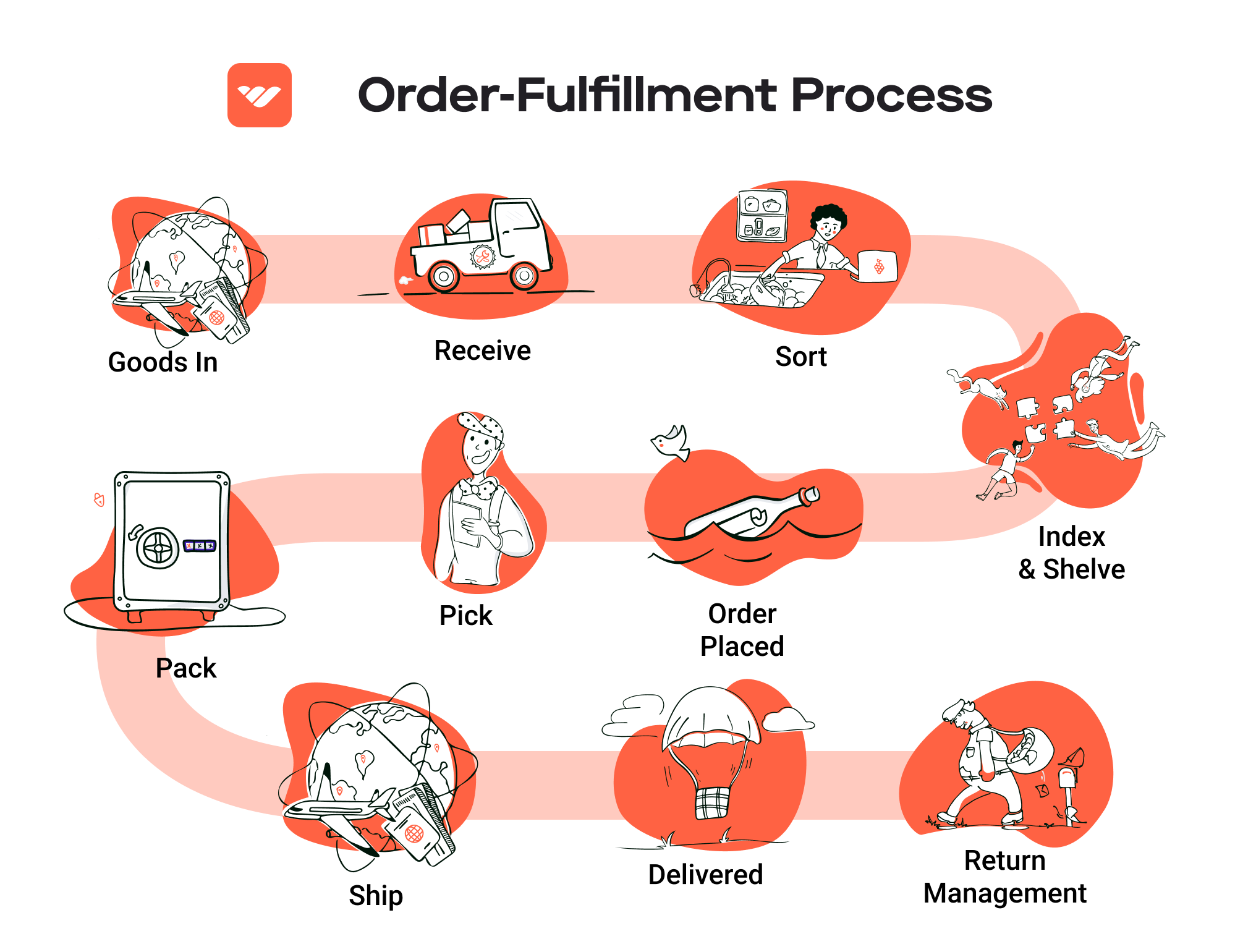
Pros of Using FBA
-
Prime Eligibility: One of the most significant advantages of FBA is that products become eligible for Amazon Prime. This status not only attracts millions of Prime members who prefer fast shipping but also enhances the chances of winning the Buy Box, a crucial aspect of sales on Amazon.
-
Customer Trust: By using FBA, sellers can leverage Amazon’s reputation for reliability and customer service. This trust can lead to higher conversion rates, as customers feel more secure purchasing from a seller that utilizes Amazon’s fulfillment services.
-
Multi-Channel Fulfillment: FBA can also be used for multi-channel fulfillment, meaning sellers can use Amazon’s logistics for orders placed on other platforms, such as eBay or their own websites. This capability allows for a streamlined fulfillment process across different sales channels.
-
Scalability: FBA allows sellers to scale their business without the need to invest in their own warehousing and fulfillment infrastructure. As sales increase, sellers can send more inventory to Amazon, allowing for growth without operational bottlenecks.
-
Time Savings: By outsourcing fulfillment to Amazon, sellers can save significant time and resources that would otherwise be spent on packing, shipping, and customer service, allowing them to focus on core business strategies.
Cons of Using FBA
-
High Fees: FBA comes with a range of fees, including storage fees for inventory stored in Amazon’s warehouses and fulfillment fees for each order processed. For sellers of low-cost items, these fees can eat into profit margins significantly.
-
Strict Inventory Rules: Amazon has strict guidelines regarding inventory management, including the minimum number of units that can be sent to a fulfillment center. Sellers must also adhere to Amazon’s policies regarding product condition and packaging, which can be cumbersome.
-
Commingling Risks: FBA uses a commingling inventory system, where products from different sellers may be stored together. This can pose a risk if there are quality issues with another seller’s product, potentially leading to negative reviews for your products.
-
Limited Control: By relying on Amazon for fulfillment, sellers may find they have less control over their shipping processes and customer interactions. This can be particularly concerning during peak seasons when delays may occur.
-
Long-Term Storage Fees: Products that remain in Amazon’s warehouses for extended periods incur long-term storage fees, which can further reduce profitability for sellers with slower-moving inventory.
Who is FBA Best For?
Fulfillment by Amazon is particularly advantageous for certain types of sellers:
-
Small to Medium-Sized Businesses: Businesses that do not have the resources to manage their own warehousing and fulfillment operations can benefit greatly from FBA, allowing them to focus on growth without the overhead costs.
-
Sellers of Low-Cost Items: For sellers who offer lower-priced items, FBA can provide a competitive edge by making their products Prime eligible and improving visibility in search results, despite the higher fee structure.
-
Brands Looking to Scale: Sellers aiming to scale quickly will find FBA’s logistics capabilities invaluable, enabling them to expand their product offerings and reach without the complexity of managing fulfillment in-house.
-
E-commerce Entrepreneurs: New entrepreneurs entering the e-commerce space can leverage FBA to access Amazon’s massive customer base and sophisticated logistics network, reducing barriers to entry.
In conclusion, while FBA presents numerous advantages such as Prime eligibility, customer trust, and streamlined operations, it also comes with challenges like high fees and strict policies. By carefully evaluating their business model and product offerings, sellers can determine if FBA aligns with their operational goals and customer satisfaction strategies.
Core Services Offered by Fulfillment Centers
Inventory Management & Warehousing
Inventory management and warehousing are foundational services provided by fulfillment centers that enable e-commerce businesses to maintain optimal stock levels while minimizing overhead costs. This process involves systematically tracking inventory, managing stock levels, and ensuring that products are stored in a manner that maximizes efficiency and accessibility.
What It Is:
Fulfillment centers utilize sophisticated inventory management systems to monitor stock levels in real-time, allowing businesses to receive alerts when inventory is running low or when specific products need to be reordered. Warehousing services include storing products in strategically located facilities designed for efficient storage and quick access.
Benefits to E-commerce Businesses:
-
Cost Efficiency: By outsourcing inventory management and warehousing to a fulfillment center, e-commerce businesses can significantly reduce the costs associated with maintaining their own storage facilities and staffing. This allows for better allocation of resources to core business activities like marketing and product development.
-
Scalability: As businesses grow, their inventory needs can fluctuate significantly. Fulfillment centers offer flexible storage options that can easily adapt to changing demands, allowing businesses to scale operations without the burden of additional infrastructure investments.
-
Improved Accuracy: Advanced inventory management systems minimize human error in stock tracking and order fulfillment, ensuring that businesses have a precise understanding of their inventory levels. This leads to better decision-making and less risk of stockouts or overstock situations.
Pick and Pack Services
Pick and pack services are essential components of the order fulfillment process that involve selecting items from inventory (picking) and preparing them for shipment (packing). This service is crucial for ensuring that customer orders are fulfilled accurately and efficiently.
What It Is:
Once an order is placed, fulfillment center staff retrieve the ordered items from the warehouse, package them according to specified standards, and prepare them for shipment. This can involve everything from simple boxing to more complex packaging requirements, depending on the product.
Benefits to E-commerce Businesses:
-
Speed and Efficiency: Fulfillment centers have streamlined processes and trained personnel dedicated to picking and packing orders quickly. This leads to faster shipping times, which can enhance customer satisfaction and loyalty.
-
Quality Control: Professional pick and pack services often include quality checks to ensure that the correct items are shipped in good condition. This reduces the likelihood of returns due to errors and helps maintain a positive brand reputation.
-
Customization Options: Many fulfillment centers offer customizable packing solutions, including branded packaging and inserts. This allows businesses to create a unique unboxing experience for their customers, reinforcing brand identity and customer engagement.
Kitting and Assembly
Kitting and assembly services involve grouping individual items together to create a single, packaged product. This service is particularly beneficial for businesses that sell products that are often purchased together or require assembly before shipping.
What It Is:
Kitting involves taking various components and packaging them as a single unit. For example, a company selling a craft kit might combine yarn, patterns, and tools into one package. Assembly might involve putting together parts of a product before it is shipped to the customer.
Benefits to E-commerce Businesses:
-
Enhanced Customer Experience: By providing complete kits or assembled products, businesses can simplify the purchasing process for customers, making it easier for them to buy what they need without searching for individual components.
-
Increased Sales Opportunities: Kitting can encourage customers to purchase more items at once, as they may be more inclined to buy a complete kit rather than individual items. This can lead to higher average order values and improved profitability.
-
Efficient Inventory Management: Fulfillment centers can manage the inventory of individual components and finished kits, allowing businesses to optimize stock levels and reduce excess inventory of slower-moving items.
Returns Management (Reverse Logistics)
Returns management, or reverse logistics, is the process of handling returned products and ensuring that they are processed efficiently. This service is critical in today’s e-commerce landscape, where return rates can be significant.
What It Is:
Fulfillment centers provide services to manage the return of products, including inspection, restocking, and processing refunds or exchanges. This involves assessing the condition of returned items, determining whether they can be resold, and updating inventory levels accordingly.
Benefits to E-commerce Businesses:
-
Streamlined Returns Process: A dedicated returns management service simplifies the often complicated process of handling returns, making it easier for customers to return items. This can enhance customer satisfaction and encourage repeat business.
-
Cost Reduction: Efficient returns management minimizes the costs associated with handling returns. Fulfillment centers can quickly process returns and restock items, reducing the time and resources needed for businesses to manage returns in-house.
-
Data Insights: By analyzing return data, fulfillment centers can provide valuable insights into customer behavior and product performance. This information can help businesses identify trends, improve product offerings, and enhance marketing strategies.
In conclusion, partnering with a fulfillment center can provide e-commerce businesses with a range of core services that not only streamline operations but also enhance customer satisfaction and drive growth. By leveraging inventory management, pick and pack services, kitting, and returns management, businesses can focus on scaling their operations while ensuring efficient and effective order fulfillment.
How to Choose a Fulfillment Partner: A 6-Point Checklist
Location & Warehouse Network
Importance:
The geographical location of your fulfillment partner’s warehouses can significantly affect shipping times and costs. A partner with strategically placed warehouses can help you reach your customers faster and reduce shipping expenses, which is crucial for maintaining competitiveness in e-commerce.
Questions to Ask:
– Where are your fulfillment centers located?
– How do you determine the optimal warehouse for shipping my products?
– Can you accommodate my needs for both domestic and international shipping?
– What are your average shipping times to various regions?
Technology & Integrations
Importance:
A robust technology platform is essential for seamless operations. The right technology can streamline order processing, inventory management, and provide real-time tracking capabilities, which enhances customer experience and operational efficiency.
Questions to Ask:
– What fulfillment software do you use, and how does it integrate with my e-commerce platform (e.g., Amazon, Shopify)?
– Can you provide real-time inventory updates and order tracking?
– How do you handle data security and compliance with industry standards?
– Are there any additional costs for technology integrations?
Specializations (e.g., cold storage, oversized items)
Importance:
Different products require different handling and storage conditions. If you sell specialized items such as perishables or oversized products, it’s crucial to partner with a fulfillment provider that has the expertise and infrastructure to manage these types of goods effectively.
Questions to Ask:
– Do you have experience handling my specific product type (e.g., cold storage, fragile items)?
– What facilities and processes do you have in place for specialized storage?
– How do you ensure compliance with regulations (e.g., health and safety standards for food items)?
– Can you manage seasonal fluctuations in inventory for specialized products?
Scalability & Capacity
Importance:
As your business grows, your fulfillment needs will evolve. A partner that can scale operations in line with your growth is essential to avoid disruptions in service and maintain customer satisfaction.
Questions to Ask:
– What is your current capacity, and how do you handle peak seasons?
– Can you scale operations quickly if my order volume increases unexpectedly?
– How do you manage inventory turnover during slow sales periods?
– What contingency plans do you have in place for unexpected demand spikes?
Pricing and Contracts
Importance:
Understanding the pricing structure and contract terms is crucial for budgeting and financial planning. Look for transparency in costs to avoid hidden fees that could eat into your margins.
Questions to Ask:
– Can you provide a detailed breakdown of your pricing structure (e.g., storage fees, picking and packing costs)?
– What are your policies on long-term contracts vs. month-to-month agreements?
– Are there any additional fees for services like returns management or special handling?
– How do you handle price increases, and what notice do you provide before such changes?
Customer Support & Reviews
Importance:
Exceptional customer support can make a significant difference in resolving issues quickly, which is vital in e-commerce. Additionally, reviews and testimonials from other clients provide insight into the fulfillment partner’s reliability and service quality.
Questions to Ask:
– What support channels do you offer (e.g., phone, email, chat)?
– What are your average response times for customer inquiries?
– Can you provide references or case studies from similar businesses?
– How do you handle complaints or issues that arise during the fulfillment process?
Conclusion
Choosing the right fulfillment partner is a crucial step in scaling your e-commerce business effectively. By following this checklist and asking the right questions, you can identify a partner that aligns with your operational needs, supports your growth ambitions, and enhances customer satisfaction. Remember, the goal is to find a partner that not only meets your current requirements but also has the capacity and flexibility to adapt as your business evolves.
Understanding Fulfillment Pricing: A Breakdown of Common Fees
Initial Setup Fees
When partnering with a fulfillment center, initial setup fees are often the first cost you will encounter. These fees cover the administrative work required to establish your account, including onboarding processes such as account configuration, system integration, and inventory setup.
The calculation of initial setup fees can vary widely depending on the fulfillment provider and the complexity of your needs. Typically, you might expect a flat fee ranging from $100 to $500. Some providers may also charge based on the volume of products or the number of SKUs you wish to manage. Always ask for a detailed breakdown to understand what services are included in this fee.
Receiving Fees
Receiving fees are charged when your inventory arrives at the fulfillment center. This fee accounts for the time and labor involved in unloading, inspecting, and storing your products.
These fees are usually calculated on a per-unit basis, meaning you pay a specific amount for each item received. For instance, a fulfillment center may charge $0.25 to $0.50 per item. If you send a shipment of 500 units, your receiving fee could range from $125 to $250. Some providers might have minimum charges or tiered pricing based on volume, so it’s crucial to clarify these details upfront.
Storage Fees (per pallet/bin)
Storage fees are incurred for keeping your products within the fulfillment center. This fee is typically calculated based on the space your inventory occupies, measured in pallets, bins, or square footage.
Fulfillment centers may charge monthly fees for storage, which can range from $10 to $50 per pallet or $0.10 to $0.50 per bin. Additionally, some providers implement long-term storage fees if your inventory remains unsold for an extended period, often six months or more. Understanding the storage fee structure will help you manage your inventory more effectively and avoid unnecessary costs.
Pick & Pack Fees (per item/order)
Pick and pack fees cover the labor involved in retrieving your products from storage, packing them for shipment, and preparing them for delivery. This fee is usually charged on a per-order or per-item basis.
For example, a fulfillment center might charge $1.00 to $3.00 per order for the picking and packing process, plus an additional fee of $0.25 to $0.75 for each item included in that order. This means that if a customer orders three items, the total pick and pack fee could be $1.00 (base fee) + $0.75 (for three items) = $1.75. Understanding this fee structure is vital as it directly impacts your overall cost per order and can help you strategize your product offerings.
Shipping Fees
Shipping fees are one of the most variable costs in the fulfillment pricing model. These fees depend on several factors, including the weight and dimensions of your packages, the shipping method chosen, and the destination.
Most fulfillment centers calculate shipping fees based on the carrier’s rates, which may include options for standard, expedited, or express shipping. You might also encounter additional fees for special handling, such as oversized items or specific delivery requirements. To provide a clearer picture, shipping fees can range from $5 to $20 for standard domestic shipping but could be significantly higher for international shipments or expedited services. It’s essential to negotiate shipping rates with your fulfillment partner to ensure competitive pricing.
Tips for Getting an Accurate Quote
-
Detail Your Needs: Provide your fulfillment partner with comprehensive details about your inventory, including the number of SKUs, average monthly order volume, and specific handling requirements. The more information you provide, the more accurate your quote will be.
-
Request Itemized Pricing: Always ask for an itemized breakdown of all potential fees. This transparency helps you understand what you are paying for and avoids any surprises down the line.
-
Compare Providers: Don’t settle for the first quote you receive. Compare multiple fulfillment centers to gauge the average costs and services offered. This competition can also provide leverage in negotiations.
-
Factor in Hidden Costs: Be aware of potential hidden costs, such as long-term storage fees or additional charges for returns. Discuss these possibilities upfront to avoid unexpected expenses.
-
Consider Volume Discounts: If you anticipate a high order volume, inquire about volume discounts or tiered pricing structures that could reduce your overall fulfillment costs.
By understanding these common fees and employing these strategies, you can make informed decisions that help streamline your fulfillment process and improve your bottom line.
Frequently Asked Questions (FAQs) about Fulfillment
1. What is Amazon’s Small and Light (SnL) Fulfillment Service?
Amazon’s Small and Light (SnL) Fulfillment Service is designed for sellers offering lightweight, low-cost products that typically do not meet the criteria for standard Fulfillment by Amazon (FBA). This service allows sellers to reduce fulfillment costs for items such as small accessories or inexpensive household goods, making it easier for them to compete in the marketplace.
2. How does SnL compare to standard FBA in terms of costs?
SnL is approximately 20% cheaper than standard FBA for lightweight items. For instance, on a $5 product weighing 2 ounces, the fees for SnL would be around $2.90, compared to about $3.70 for standard FBA. This cost reduction can significantly improve margins for sellers focused on low-priced items.
3. What are the key benefits of using SnL?
The primary benefits of using SnL include reduced fulfillment costs, eligibility for the Buy Box over non-FBA sellers, free shipping for all customers (including non-Prime members), and managed customer service by Amazon. This can enhance visibility and sales potential for your products.
4. Are there any downsides to using the SnL service?
Yes, there are some limitations. SnL items are not eligible for Same Day or 2-Day shipping, which may deter some customers. Additionally, sellers must send a minimum of 30 to 50 units per SKU, and products may require additional labeling, even if they already have barcodes. There are also higher long-term storage fees associated with this service.
5. What is the difference between a warehouse and a fulfillment center?
A warehouse is primarily used for storing inventory, while a fulfillment center specializes in processing orders for shipment. Fulfillment centers are equipped with technology and processes to pick, pack, and ship products efficiently, often integrating with e-commerce platforms to streamline order management.
6. What is a 3PL (Third-Party Logistics provider)?
A 3PL is a company that provides outsourced logistics services, including warehousing, fulfillment, and shipping. For e-commerce businesses, partnering with a 3PL can help manage inventory and order processing, allowing sellers to focus on core business activities while ensuring efficient delivery to customers.
7. How much do fulfillment services cost?
Fulfillment service costs can vary widely based on factors such as order volume, storage needs, and specific service offerings. For SnL, costs typically include storage fees, picking and packing fees, and shipping costs. It’s essential to review pricing structures from various providers to find a solution that aligns with your business model.
8. Can I use SnL for multi-channel fulfillment?
While SnL is primarily designed for Amazon sellers, it can also be used for multi-channel fulfillment, though additional fees may apply. For instance, fulfilling orders from other marketplaces or your own website could incur extra costs. It’s important to evaluate the total expenses associated with multi-channel fulfillment to ensure profitability.
9. How can I transition from FBA to SnL or a 3PL service?
Transitioning from FBA to SnL or a 3PL involves several steps, including assessing your inventory, choosing a provider, and integrating your e-commerce platform with their fulfillment system. It’s advisable to work with a fulfillment expert who can guide you through the process, ensuring compliance with Amazon’s requirements and minimizing disruptions.
10. What support does Amazon provide for SnL sellers?
Amazon offers various resources for SnL sellers, including guidelines for inventory preparation, compliance with labeling requirements, and access to seller support for operational inquiries. However, it’s important to note that while Amazon handles customer service, sellers retain responsibility for product quality and overall customer satisfaction.
Conclusion: Is Outsourcing Fulfillment the Right Move for Your Business?
Evaluating the Benefits of Outsourcing Fulfillment
Outsourcing your fulfillment process can be a transformative decision for your e-commerce business. By leveraging a fulfillment service, you can save significant time, allowing you to focus on your core competencies such as product development, marketing, and customer engagement. Fulfillment partners streamline the logistics of storage, packing, and shipping, ensuring that your orders are processed efficiently and accurately.
Scalability is another crucial advantage of outsourcing fulfillment. As your business grows, so do your logistics demands. A reliable fulfillment partner can easily scale operations to accommodate increased order volumes without the need for hefty investments in warehousing or staffing. This flexibility is particularly beneficial during peak seasons or promotional events, where order spikes are common.
Moreover, partnering with a fulfillment service brings specialized expertise that can enhance your operations. These providers are well-versed in the complexities of e-commerce logistics, including compliance with platforms like Amazon and navigating multi-channel sales. They also offer insights into inventory management and customer service, which can significantly improve your operational efficiency and customer satisfaction.
However, it’s vital to choose the right fulfillment partner for your business. The wrong choice can lead to increased costs, poor service quality, and damage to your brand reputation. Conduct thorough research, assess potential partners’ capabilities, and ensure they align with your long-term growth strategies.
Take Action Today
To determine if outsourcing fulfillment is the right move for your business, start by auditing your current shipping processes. Evaluate your operational bottlenecks, costs, and customer feedback. This exercise will provide clarity on whether a fulfillment partner could enhance your efficiency and support your growth objectives. Don’t hesitate to reach out to potential partners for consultations; the right support can be a game changer for your e-commerce success.
Important Disclaimer
⚠️ Important Disclaimer
The information in this guide is for educational purposes. Fulfillment services, pricing, and platform features change frequently. Always conduct your own due diligence and consult with providers directly before making business decisions.
